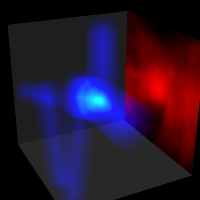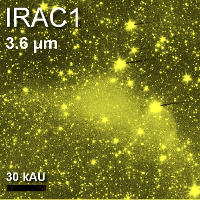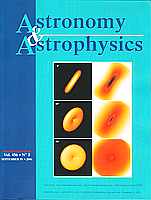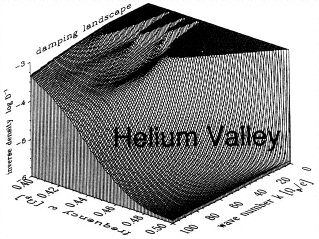| j ü r g e n s t e i n a c k e r |
| s c i e n c e h i g h l i g h t s |
| Core Mass Functions | |
 |
Molecular cloud cores are the birthplace of stars. To understand the star formation
process, scientists often condense the information about cores into a single
mass distribution called "core mass function" (CMF). In a recent paper (Steinacker et al. 2016), we show that estimating the mass of the core is difficult and requires better techniques than commonly applied. The result is that the masses of cores might have been underestimated by factors easily reaching 10. This questions the derived star formation rate and efficiencies. Further core modeling work includes: + Cores do not contain much hidden cold gas (Steinacker et al. 2016, subm.) + Detailed modeling of the standard core B68 (Nielbock et al. 2012) + 3D Modeling of a core (Steinacker et al. 2005) |
| Coreshine | |
|
Mixed in the gas of molecular cloud cores are small solid grains called cosmic dust.
They are the building blocks of the planet formation process that occurs later when
the star has formed from the core gas. Since the grains scatter radiation they can
be found analyzing scattered light images from cores. Surprizingly, even at mid-infrared wavelength such scattered light from the core centers ("coreshine", APOD) was found (Pagani, Steinacker et al. Science 2010) and explained by grains that are already grown to 1 micrometer-sized grains (Steinacker et al. 2010). Their origin remains unknown. Further coreshine work includes: + Using 4.5 μm radiation to constrain the grain sizes (Steinacker et al. 2015) + Coreshine and ice-mantles share the same extinction threshold (Andersen et al. 2014) + Exploring the origin of large grains in L1506C (Steinacker et al. 2014a) + Coreshine detection conditions (Steinacker et al. 2014b) + Coreshine in L260 (Andersen et al. 2013) |

|
| 3D Dust Radiative Transfer | |
 |
Radiative transfer is one of the major tools to analyze astronomical data.
Due to its high dimensionality and the non-linear and non-local transport equation
it is also a severe computational challenge. We have been invited by Annual Reviews of Astronomy and Astrophysics (highest impact journal in astrophysics) to write the first review on 3D dust radiative transfer (Steinacker, Baes, and Gordon 2013). We have organized radiative transfer workshops and test codes in a large international collaboration called TRUST (3D Benchmarks for the Transport of Radiation through a DUSTy Medium, Gordon et al. 2017). Further radiative transfer work includes: + Benchmarking codes with stochastic heating of grains (Camps et al. 2015) + Ray-tracing through high-opacity structures (Steinacker et al. 2006) + The first 3D modeling of a core (Steinacker et al. 2005) + Core Evolution as seen by radiative transfer (Steinacker et al. 2004) + Benchmarking 2D radiative transfer (Pascucci et al. 2003) + Adaptive multi-frequency grids for radiative transfer (Steinacker et al. 2002a) + Exact solutions for inverse 1D radiative transfer (Steinacker et al. 2002b) + Numerical diffusion in radiative transfer (Steinacker et al. 2002c) + Integrating intensities on the unit sphere (Steinacker et al. 1996) |
| Disks around massive stars | |
|
The formation of massive stars is substantially more complex than that of low-mass stars
like our own sun. The densities are much higher, the physical processes act on much
smaller timescales, and in almost all cases massive stars form in clusters. One of the key questions is if the massive stars form through an accretion disk around the proto-star like their low-mass counterparts. For a disk candidate around a massive proto-star in M17, we have performed a detailed modeling of the disk structure that is seen in silhuette (Steinacker et al. 2006). Further work about disk candidates around massive proto-stars includes: + A large massive rotating disk around an isolated proto-star (Quanz et al. 2010) + Probing the center of the large disk in M17 (Nielbock et al. 2008) + A disk candidate around a hypercompact HII region (Nielbock et al. 2007) + A disk remnant around a massive star (Chini et al. 2006) |

|
| Plasma waves and particle acceleration | |
 |
Plasmas like in the solar atmosphere can show a rich spectrum of waves, some of them with
electric field components that will interact with the charge particles in the plasma.
Depending on the properties of the particles and the waves the interaction can lead
to a net acceleration. We have investigated the Fokker-Planck equation descring the evolution of an electron distribution function in the presence of a spectrum of cold plasma turbulence (Steinacker & Miller 1992). Determining the coefficients, we found a new resonance and discussed its influence on the electron distribution for waves propagating in both directions. Proceeding to warm plasma waves in a realistic solar flare plasma with a ion species observed, we investigated the substantial overabundance of some Helium ions that can be created by preferential acceleration (Steinacker et al. 1997). Since 4He+2 is much more abundant that other ions with the same gyrofrequency, it suppresses any acceleration due to ion cyclotron waves forming a Helium valley of acceleration efficiency. Further plasma wave work includes: + Ion acceleration in impulsive solar flares (Steinacker et al. 1993) + Thermal effects influencing stochastic gyroresonant electron acceleration (Miller & Steinacker 1992) + Extending quasi-linear theory for the transport of charged particles in a turbulent plasma (Achatz et al. 1991) + A new class of impulsive flares with no nuclear gamma-ray line emission (Bech et al. 1990) + Acceleration of solar protons in the transrelativistic regime (Steinacker & Schlickeiser 1989) + Acceleration of non-relativistic protons and relativistic electrons (Steinacker et al. 1988, Schlickeiser & Steinacker 1989) |